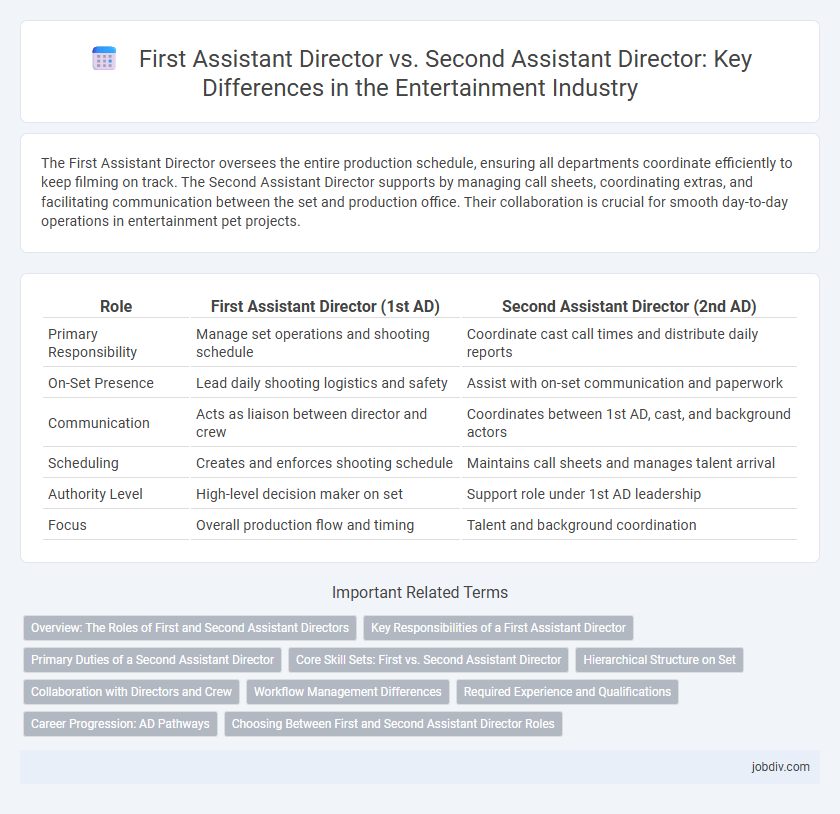The First Assistant Director oversees the entire production schedule, ensuring all departments coordinate efficiently to keep filming on track. The Second Assistant Director supports by managing call sheets, coordinating extras, and facilitating communication between the set and production office. Their collaboration is crucial for smooth day-to-day operations in entertainment pet projects.
Table of Comparison
| Role | First Assistant Director (1st AD) | Second Assistant Director (2nd AD) |
|---|---|---|
| Primary Responsibility | Manage set operations and shooting schedule | Coordinate cast call times and distribute daily reports |
| On-Set Presence | Lead daily shooting logistics and safety | Assist with on-set communication and paperwork |
| Communication | Acts as liaison between director and crew | Coordinates between 1st AD, cast, and background actors |
| Scheduling | Creates and enforces shooting schedule | Maintains call sheets and manages talent arrival |
| Authority Level | High-level decision maker on set | Support role under 1st AD leadership |
| Focus | Overall production flow and timing | Talent and background coordination |
Overview: The Roles of First and Second Assistant Directors
First Assistant Directors (1st ADs) manage the overall scheduling, coordinate the cast and crew, and ensure the production stays on track during filming. Second Assistant Directors (2nd ADs) support the 1st AD by handling call sheets, organizing talent logistics, and maintaining communication between departments. Both roles are essential for maintaining order and efficiency on set, contributing to a smooth production process.
Key Responsibilities of a First Assistant Director
The First Assistant Director (1st AD) manages the film set's daily operations, including scheduling, coordinating cast and crew, and ensuring the production stays on track. This role involves leading safety protocols, overseeing rehearsals, and facilitating clear communication between the director and various departments. The 1st AD is crucial for maintaining efficient workflow and resolving on-set challenges to meet production deadlines.
Primary Duties of a Second Assistant Director
The primary duties of a Second Assistant Director (2nd AD) include managing the daily call sheets, coordinating the cast's arrival on set, and ensuring timely communication between the production office and the set. They assist in organizing background actors and support the First Assistant Director (1st AD) by maintaining order and efficiency during shooting schedules. The 2nd AD plays a critical role in facilitating smooth operations and adherence to the production timeline.
Core Skill Sets: First vs. Second Assistant Director
The First Assistant Director (1st AD) excels in leadership, scheduling, and overall set management, ensuring the production stays on track by coordinating between departments and managing shooting timelines. The Second Assistant Director (2nd AD) specializes in communication, preparing call sheets, and facilitating cast and crew movements, focusing on logistical support and coordination. Both roles require strong organizational skills, but the 1st AD emphasizes high-level decision-making and time management, while the 2nd AD concentrates on detail-oriented execution and personnel coordination.
Hierarchical Structure on Set
The First Assistant Director (1st AD) oversees the entire set's operations, managing the shooting schedule, coordinating between departments, and ensuring the director's vision is executed efficiently. The Second Assistant Director (2nd AD) handles logistics such as preparing call sheets, managing the cast's movements, and assisting the 1st AD with communication flow. This hierarchical structure ensures seamless production flow, with the 1st AD holding primary leadership and the 2nd AD supporting operational execution.
Collaboration with Directors and Crew
The First Assistant Director (1st AD) coordinates closely with the director to manage the shooting schedule, ensuring that each scene aligns with the director's vision while maintaining efficiency on set. The Second Assistant Director (2nd AD) supports the 1st AD by organizing call sheets, managing cast movements, and facilitating communication between the director and the crew. Effective collaboration between the 1st AD and 2nd AD is crucial for synchronizing director's creative goals with the operational needs of the production team.
Workflow Management Differences
The First Assistant Director (1st AD) oversees the entire set's workflow, coordinating between departments to ensure the production stays on schedule and managing on-set operations. In contrast, the Second Assistant Director (2nd AD) focuses on preparing call sheets, managing the movement of cast and crew, and facilitating communication between the director's office and various departments. The 1st AD handles strategic workflow management, while the 2nd AD executes tactical tasks to keep daily operations running smoothly.
Required Experience and Qualifications
First Assistant Directors typically require extensive experience in film production, often having worked their way up through roles such as Second Assistant Director or production assistant, along with strong leadership and organizational skills. Second Assistant Directors usually need foundational knowledge of scheduling, communication, and set operations, often gained through internships or entry-level production roles, with a focus on coordinating cast and crew. Both positions benefit from certifications in film production and a solid understanding of industry-standard software like Movie Magic Scheduling.
Career Progression: AD Pathways
The First Assistant Director (1st AD) typically oversees the set's daily operations, coordinating schedules, managing cast and crew, and ensuring the director's vision is executed efficiently. The Second Assistant Director (2nd AD) supports the 1st AD by organizing call sheets, managing extras, and handling administrative tasks on set. Career progression in the Assistant Director pathway commonly begins as a 2nd AD, advancing to 1st AD with experience and proven leadership skills in managing complex production logistics.
Choosing Between First and Second Assistant Director Roles
Choosing between First Assistant Director (1st AD) and Second Assistant Director (2nd AD) roles depends on experience and responsibility preference; the 1st AD manages the overall shooting schedule and coordinates crew, while the 2nd AD handles cast logistics and paperwork. The 1st AD requires strong leadership and planning skills, ideal for those aiming to oversee production flow. Opting for the 2nd AD role offers a chance to gain set management experience and support the 1st AD, making it suitable for emerging professionals seeking entry into film production management.
First Assistant Director vs Second Assistant Director Infographic

 jobdiv.com
jobdiv.com